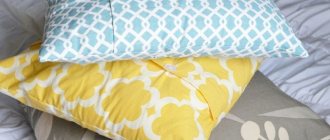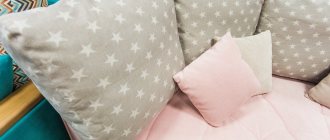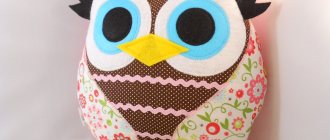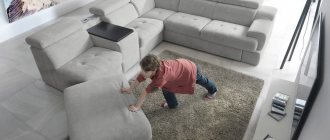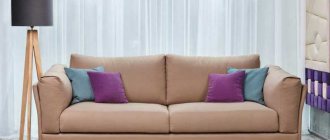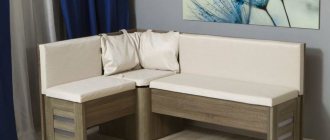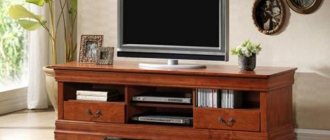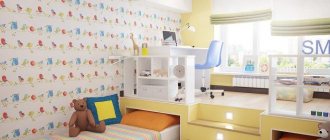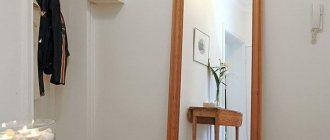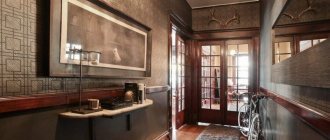Home / Fillers
Back
Published: 07/01/2021
Reading time: 3 min
0
12
Decorative pillows are the finishing touch that makes the interior complete. It is necessary to select them so that they match the style of the room, to be able to place them correctly, and this largely depends on the filler used. At the same time, the pillow is designed not only to decorate the interior. First of all, they are needed for comfort - to place them under your head or back to relax and unwind. Let's consider the question of which filler for decorative pillows is best, because there are a lot of them now and each has its own characteristics.
- 1 Main requirements for the material
- 2 Artificial fillers
- 3 Natural fillers
- 4 Compare and make a choice
- 5 Stuffing technique
- 6 Conclusion
Main requirements for the material
Different raw materials are used to fill pillows, each with its own pros and cons. When choosing a filler, take into account the following factors:
- comfort. It’s all individual, depending on who is comfortable. But this requirement is taken into account first of all, since the quality of rest/sleep and the health of the spine will depend on the comfort of the pillow;
- no allergens. This is especially important if the pillow is taken for pregnant women or children who need to take care not only of comfort, but also of their health;
- ability to pass air. If the filler is ventilated, it will provide greater comfort, regardless of the ambient temperature. At the same time, the pillow will keep its shape longer and remain “fresh”;
- hygroscopicity (the ability to absorb moisture). The padding should dry quickly, which will ensure an optimal microclimate and prevent the appearance of bacteria;
- ability to maintain shape. If the filler is of high quality, it will not bunch up in one part of the pillow, but will be distributed evenly;
- life time. Good products last 5-7 years, but during this time the properties of the pillow for which they were taken should not change.
Fact! Nowadays handmade is popular - needlewomen sew the products themselves, and it is also important for them to know what type of filling is best for sofa pillows.
Durafil
Durafil is a multi-layer, highly elastic, thermally bonded fabric with vertically directed fibers and an aerodynamic layout, which has low residual deformation. Durafil is a white, soft, delicate polymer. It has oriented vertical fibers and therefore works like a spring block. This soft and fluffy filler is used in the manufacture of upholstered furniture as a filler for seats, backs and armrests of sofas and armchairs. Upholstered furniture made using Durafil filler has the best consumer characteristics: the seats and backs of sofas have the ability to restore their shape after pressure or weight loading, while retaining this feature for a long time. Durafil does not cause allergies, does not absorb moisture and does not support combustion. The filler does not harbor colonies of dust mites, moths and mold fungi. The correct choice of types of flooring materials and their competent combination largely determine the quality and comfort of upholstered furniture. The following auxiliary flooring materials are used in production: batting, quilted padding, felt, spunbond and many others.
Artificial fillers
For a long time it was believed that synthetic material could not compete with organic material. But technology is developing, and now they can make fillers that have special characteristics, meet any conditions, are durable and hypoallergenic.
How to stuff a sofa pillow:
- memory foam. A popular option is a viscoelastic foam characterized by a “memory effect”. Taking into account pressure and temperature, it remembers the position in which a person sleeps. The peculiarity of the foam is that it does not press down too much - just enough to be comfortable. Memory foam filler is often used by manufacturers of orthopedic pillows, since it can be “sculpted” into any shape;
- silicone Raw materials in the form of polyester fibers or beads. This filler is light, soft, quite elastic, hypoallergenic and does not attract dust. A pillow stuffed with silicone can be washed in a washing machine, but on a delicate cycle. The only downside is that the service life is no more than 3 years;
- holofiber. The material is hollow fiber-springs that weigh little, are elastic and voluminous. Thanks to the fibrous structure, heat and moisture are well removed. Holofiber does not cause allergies;
- polyester fiber. The special composition helps this material to effectively retain heat, while allowing air to pass through and moisture to be wicked away. But the pillows are not firm enough and are not able to properly support the head and neck. Another weak point is the service life, which is 2 – 2.5 years;
- polyurethane foam. The filler in the form of artificial foam provides support, is able to restore shape and is not a breeding ground for microorganisms. Pillows stuffed with this material are inexpensive, which is also a plus;
- artificial swan down. Another name is microgel. This is a light, elastic raw material that quickly restores shape and provides orthopedic support. Such pillows are expensive, but they also last a long time - at least 7 years.
Fact! There are other types of fillers, the same microfiber, polystyrene foam balls, etc., but these are the main ones.
Sintepooh
Synthetic fluff is the name of the filler, the cheapest of the existing fillers, which are widely used in furniture production . Today this is the best alternative to natural down. This fiber is treated with a special silicone emulsion, which gives it qualities that allow it to be called an artificial down substitute. Synthetic down is artificial down - a hollow, highly crimped siliconized fiber, 100% polyester, a single component of which in space has the appearance of a spiral spring. The length of the coil is 57 mm. These individual components, intertwined with each other, form a strong springy fiber structure. This property allows synthetic fluff to quickly restore its shape after being crushed and to have high resistance to maintaining its shape over time. The elastic, compressible structure of synthetic down is soft, breathable, and does not create a “greenhouse effect” during prolonged use. Lightness, softness, elasticity, volume, warmth, environmental friendliness, hypoallergenicity, resistance to washing and dry cleaning - these are the qualities synthetic fluff . The hypoallergenic and environmentally friendly nature of synthetic down is explained by the absence of substances harmful to human health in its production. In addition, synthetic fluff does not absorb foreign odors. Sintepooh is not afraid of water; when wet, it still retains heat. Synthetic down does not roll or fall off, which cannot be said about natural down. Synthetic down is used as a filler for backrests, armrests, decorative pillows and other upholstered furniture products .
Fillers of natural origin
These are raw materials obtained from natural components, environmentally friendly and durable, capable of lasting longer than analogues invented in laboratories. But natural filling for sofa cushions can cause allergies, so you should choose it carefully. Raw materials are divided into two groups - animal and plant origin. Let's consider the options:
- down and feather. These were once the most popular materials collected when poultry moulted. Pillows with such filling weigh little, are able to wick away moisture well and retain heat (and this is an important point if you live in a northern climate). But such models are losing popularity, since the raw materials become clumps over time, feathers begin to come out of the edges, and they cannot be washed - only in dry cleaning;
- wool. Bedding is often stuffed with sheep or camel hair, as a raw material that retains heat, combines softness and elasticity, and provides comfort. But it quickly loses its shape and is short-lived. Wool is also characterized by high hygroscopicity, and over time can become a medium for the development of bacteria;
- cashmere. This is the down of goats grazing in Pakistan and India. The material is expensive, but worth it: hypoallergenic, tactilely pleasant, adapts to load and does not roll down for a long time;
- bamboo. The filling in the form of bamboo cellulose fibers is soft and at the same time retains its shape. At the same time, it can withstand washing without problems;
- latex. The raw material for creating the material is the Hevea tree, common in the tropics. The uniqueness of latex is its elasticity and density, and the filler itself, in the form of springy foam, can easily adapt to the shape of the neck and head;
- buckwheat or cedar husk. The filler has orthopedic properties, but is not suitable for every day, so it is usually used as prescribed by a doctor. A pillow stuffed with husks is interesting because it massages the soft tissues of the head, neck and shoulders.
Fact! Also popular are natural fillers such as flax, eucalyptus, cotton fibers, soybean oil foam, and silk.
Padded quilted flooring
Vatniki are cotton wool, covered with fabric on one or both sides and stitched with threads. The following fabrics are used for the manufacture of quilted jackets: investment, sack, technical calico, gauze. Padded jackets are quilted with thread on a sewing machine in parallel rows with a certain distance between the rows. Thus, the quilted flooring is a natural material , consisting of two layers of dense fabric with a 5-centimeter layer of cotton wool laid between them. Padded padding is one of the fillers for upholstered furniture. Technologically, quilted flooring to give greater softness and evenness to the sleeping area of the sofas. Quilted padding is widely used in the furniture industry as a cushioning material between other fillings of sofas, as well as to increase the comfort of a sleeping place.
Compare and make a choice
You can stuff a home decorative pillow with different raw materials, and everything is individual. Depending on the conditions, one or another option will be suitable. Criterias of choice:
- age. For children, hypoallergenic fillers with an average level of elasticity are optimal, for older people - soft, for adults - elastic, well holding the chosen position;
- health status. If there are problems with the spine, allergic reactions, this must be taken into account first;
- where the pillow will be used. You should start from the microclimate in the room, the frequency of cleaning and cleaning. There is no point in taking a large thick pillow with expensive filling and placing it on a sofa that is rarely used - it will quickly become covered with dust and will need dry cleaning;
- product testing. The pillow lasts for years, and there is nothing wrong with asking the store clerk about the opportunity to lie on it. Do not forget about the accompanying documentation, which describes the composition of the product.
Comparative table (5-point system).
| Padding | Rigidity | Shape recovery |
| Memory foam | 4 | 5 |
| Silicone | 3 | 5 |
| Holofiber | 3 | 4 |
| Polyester fiber | 3 | 3 |
| Polyurethane foam | 3 | 5 |
| Migrogel | 2 | 3 |
| Down and feather | 2 | 5 |
| Wool | 3 | 3 |
| Cashmere | 3 | 3 |
| Bamboo | 3 | 3 |
| Latex | 3 | 5 |
| Husk | 5 | 2 |
Fact! Synthetic filled pillows are cheap but don't last long. But they tolerate high humidity and washing in a washing machine very well.
Rubber-fabric belts
Most often, furniture upholstery uses a frame formed by furniture tapes - belts . They are located in the inner part of the seat and back, and for greater strength they are woven together perpendicular to each other. The tapes, as a rule, are tightly stretched and should completely cover the space on which the springs or filler will be located during the production or upholstery process. Rubber-fabric belts consist of rubber and synthetic fibers, pressed and glued together. Rubber-fabric belts stretched in the form of a mesh on a wooden frame are a type of base for sofas and armchairs, and backs of chairs . They are tensioned by a special machine that ensures uniform tension of the belts. Belts have varying degrees of stretch. Softer belts are used on the backs of upholstered furniture, while harder ones are used on the seats of sofas and armchairs.
Choosing the right pillow
As we have already noted, choosing a pillow is an individual matter for everyone. It is not recommended to buy the same products for all household members. And all because some people find it comfortable to sleep on a hard pillow, while others like a softer one. A product selected taking into account individual needs will promote deep sleep and good rest.
The pillow should be changed every two years. If it has feather filling, it is recommended to change it every six months.
When sleeping, try to ensure that not only your head, but also your neck is placed on the product. If you wake up with neck pain, then the pillow is too high, and if you constantly put your hand under your head or under the product itself, then it’s too low.
When buying a pillow, you should pay attention to the following details:
- Mattress. Pay attention to what kind of mattress you have. If it is soft, then the pillow should be higher, and if it is hard, then lower.
- Form. These products are available in a variety of shapes: from the classic rectangular to the intricate diamond shape. It is worth remembering why you need a pillow. If exclusively for sleeping, then it is better to choose a classic or oblong shape, since such models will provide good support for the cervical vertebrae. You can also choose an orthopedic model.
- Sewing. When choosing a product, pay attention to its tailoring. The seam must be strong, because the durability of the pillow depends on it. There should not be any small holes in the material, as filler can escape through them.
- Size and height. You should not pay special attention to the size; choose the one that will be convenient for you. The desired height of the pillow can be determined by measuring the width of your shoulder.
- Rigidity. The rigidity of the product is selected depending on the position in which you like to sleep. For those who prefer to sleep on their sides, it is better to choose a hard pillow; for those who like to sleep on their backs, it is better to choose a medium-firm pillow; and for those who sleep on their stomachs, it is better to choose a soft one.
- Filler. The softness and elasticity of the product depends on its filler. The main goal should be to ensure the correct position of the spine, as well as to promote relaxation of the neck and back muscles. Therefore, the choice of filler should occupy an important place. They come in two types - natural and synthetic. Natural ones are usually more expensive, some of them can cause allergies and require special care, while synthetic ones are not in great demand due to their artificiality.
Snake springs
“Snake” (snake spring block) is a type of springs that are used in the furniture industry. “Snake” works in tension and in most cases they are used at the base of soft elements, such as furniture seats . The springs are attached to the frame of the sofa across. The number of springs placed in furniture depends on its size, as well as on its purpose. The coil spring can be used in beds, couches, mattresses, as well as sofa beds. Such springs can be attached in different ways. The frame of the product, which has a base made of these springs, is stable and does not sway. The main advantages of using “Snake” springs are the level base of the sofa, as well as noiselessness. The springs of sofas and armchairs are made of galvanized metal and have a “ snake ” shape. When making seats, large-section wires are used, so they are more rigid than on the backrest. To prevent the seat from sagging, the spring is well hardened. Snake springs give upholstered furniture - sofas and armchairs - elasticity and an orthopedic effect. They are installed on the frame as a base for soft elements, providing comfort and reliability in operation.
Armor
The armor is made using special equipment from beech or birch veneer. In recent years, beech armor has been rare. Perhaps the reason for this is that they are much more expensive than birch ones. Lata is a bent-glued product. The layers of wood are glued together using a special technology, resulting in a bent product ( plate ), which has the ability to bend under the load placed on it. On a metal frame, the armor is located in special plastic armor holders, which are fastened with brackets over the frame. This way the armor is held tighter and does not pop out. Battens are also installed as a base for the flooring of some models of upholstered furniture , as well as for metal-frame mechanisms for transforming sofas and armchairs. Breakage or deformation (loss of bending) are the main defects of bent-glued elements. The batten breaks, as a rule, in the middle part due to loads exceeding the norm. Deformation refers to the process of natural wear and tear during operation. It must be said that the more armor is installed, the less each of them is deformed. The damaged armor bends in the opposite direction or becomes straight. The armor cannot be repaired, so if it breaks or becomes deformed, it must be replaced.
